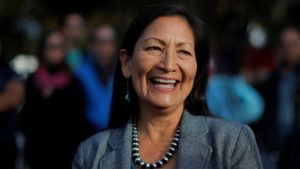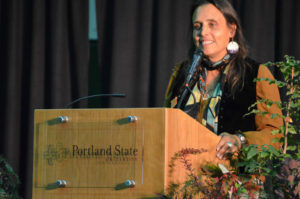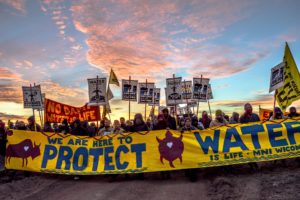Interview with Winona LaDuke by Amy Goodman, host, Democracy Now
Editor’s Note: When President-Elect Joe Biden announced on December 17th that he had nominated a Native American congresswoman from New Mexico to head up the Department of Interior, indigenous communities across the nation reacted with astonishment and tears of joy. The Washington Post responded cautiously: “American Indians have high hopes that Deb Haaland, Biden’s pick for interior secretary, can reset the troubled relationship between the federal government and Indigenous peoples.” But then the paper added a caveat, “Can she deliver?”

The Post described a long history of abuse of native Americans, and quoted Congresswoman Haaland’s speech at the Democratic National Convention: “My people survived centuries of slavery, genocide and brutal assimilation policies, but throughout our past, tribal nations fought for and helped build this country.” The proverbial elephant in the room, however, was whether Haaland could “meet the daunting challenge of balancing the preservation of cultural sites with energy development preferred by corporations that generates royalties for taxpayers and, in some cases, tribes.”
Democracy Now’s Amy Goodman addressed this concern head -on with longtime Indian activist Winona LaDuke, who is now executive director of Honor the Earth. Both LaDuke and Haaland joined protestors at Standing Rock, North Dakota in 2016 to challenge the efforts of a giant corporation to run the Dakota Access pipeline through Indian territory. Below is a transcript of Goodman’s two-part interview for Democracy Now.
Part I: Winona LaDuke: Deb Haaland’s Nomination for Interior Sec. Is “Important Step” for Native Americans
President-elect Joe Biden has nominated New Mexico Congressmember Deb Haaland to become secretary of the interior. If confirmed, she’ll be the first Native American to serve in a Cabinet position. Haaland’s nomination was backed by progressives, as well as more than 120 tribal leaders, who sent a letter to Joe Biden last month urging him to select her for the post.
Haaland responded in a statement, quote, “As our country faces the impacts of climate change and environmental injustice, the Interior has a role and I will be a partner in addressing these challenges by protecting our public lands and moving our country towards a clean energy future,” she said.
Journalist Julian Brave NoiseCat tweeted, “After four years of fossil fuel executives and lobbyists opening up Native lands and sacred sites to industry tycoons, the next Secretary of Interior will be a Laguna Pueblo woman who went to Standing Rock in 2016 and cooked for the people,” unquote.
Deb Haaland’s appointment comes as the struggle against the Enbridge Line 3 pipeline continues in Minnesota after construction began two weeks ago. Indigenous and environmental activists have been holding daily protests against the project, which would carry tar sands oil from Alberta, Canada, to a terminal in Superior, Wisconsin, cutting through Indigenous territory and running under more than 200 streams. On Monday, 22 water protectors were arrested in the freezing cold at a Line 3 construction site.
Well, for more on Deb Haaland’s historic nomination and the ongoing resistance at Line 3, we’re joined in Sandy Lake, Minnesota, by Winona LaDuke, executive director of Honor the Earth and rural development economist. She is the author of the upcoming book, To Be a Water Protector. Winona lives and works on the White Earth Reservation in northern Minnesota.

Winona, welcome back to Democracy Now! Can you start off by talking about the significance of Deb Haaland to be the first Native American to head the Interior Department, if approved by the Senate — not to mention to be a Cabinet member, as far as we know? You are a longtime supporter of her, back to when she ran for Congress.
WINONA LADUKE: I just want to say one thing: [ululation]. That would be an affirmation from all of us over here in Indian Country.
That was a very, very important step for the Biden administration. You know, Indian people know how to take care of this land. And Deb Haaland comes from Laguna Pueblo, which has one of the largest uranium mining histories in this country — you know, the Anaconda uranium mine destroying so much of their territory.
[I’m] really grateful for this new vision that we’re going to have. There’s a lot of work to do to undo what the Trump administration has done. And we are really, really grateful that the Biden administration has taken these steps.
AMY GOODMAN: And can you talk about what Deb Haaland stands for — she is a congressmember from New Mexico; she talked immediately about sustainable development — and what the Interior Department does?
WINONA LADUKE: Well, the Interior Department is kind of like the “Great White Father” of Indian people. And so, mines and Indians are both in the same department. And what’s happened is, is that the Interior Department and the federal government has basically given away so much of the land, water and resources of Indian Country under the Trump administration and previous administrations. And so, let’s just say the public lands and the Native lands should be protected for the public and the Natives, not necessarily some mining corporations.
Deb’s history here, with a vision that she and other leaders have had in Washington with a just transition and the Green New Deal, is exactly what we need in this country. We don’t need any more fossil fuels. We’re done. We’re done. What we need is the vision and a just transition.
AMY GOODMAN: And who has run the Interior Department before? I mean, what have been the policies before? And what are the pressures she’ll be under? Many have talked about Joe Biden’s Cabinet being largely still from corporate establishment America, and certainly Deb Haaland comes from a very different place.
WINONA LADUKE: Yeah, I mean, I’m sure that Deb can stand up to the challenges, and she’ll have a lot of support. I mean, I think that we should be done with appointing corporate heads to run parts of our government. They have enough influence already.
And so, in this moment in time, you have vast territories of lands that she is going to be able to look at and really provide some redress from what the Trump administration has done, basically deconstructing any environmental regulations we had and any protection of “public lands” that we had. You know, so significant prior to this, all white males in this position. And so we’re really grateful that the new administration has seen the merits of the championship of the environment and of Native people of someone like Deb Haaland.
Part II The Pandemic Pipeline: Land & Water Defenders Continue Resistance to Enbridge Line 3 in Minnesota.
Indigenous and environmental activists have been holding daily protests against the construction of the Enbridge Line 3 pipeline, which would carry tar sands oil from Alberta, Canada, to a terminal in Superior, Wisconsin, cutting through Indigenous territory and running under more than 200 streams. Winona LaDuke, director of the group Honor the Earth, says the project’s approval amid a historic slump in oil prices and accelerating climate crisis make it unsound on economic and environmental grounds. “This is the end of the fossil fuel era,” LaDuke says. “The industry is ending, and there’s certainly no reason to approve a new tar sands pipeline.”
AMY GOODMAN: And [what is] the significance of [Deb Haaland] going to Standing Rock? Which brings us to Enbridge 3 and what this is all about, these very similar struggles. And if you can make the connections? Back in 2016, I was with you at Standing Rock covering what you were doing. You pitched your tent there. And Deb Haaland was there also.

WINONA LADUKE: Yes, she was. A lot of people came to Standing Rock and were politicized, because it’s this moment in time that we realized that the rights of corporations have superseded the rights of people. And the question is, you know, let us protect our water.
The Standing Rock DAPL battle came after our successful defeat of Enbridge in the Sandpiper, a fracked-oil pipeline that Enbridge wanted to put through our territory. After that project was canceled in 2016, the company picked up, purchased 28% of the Dakota Access pipeline and proceeded to ram a pipeline through — really bad idea — North Dakota, and was faced with all of the water protectors.
And so, what we’ve seen is that this is the end of the fossil fuel era. I mean, the fact is, is that the price of oil was — I think, was at minus-$38 a barrel in the spring. I mean, that was in even my economics class. And then you had this reduction in oil consumption, the crashing of the tar sands industry — I mean, company after company is bailing out of the tar sands — and the closure of refineries in the United States. And so, we’re at this point in time where the industry is ending, and there is certainly no reason to approve a new tar sands pipeline. It’s like the last tar sands pipeline at the end of the fossil fuel era.
So, we are sitting here in northern Minnesota, and we have been standing against Enbridge’s proposal, you know, for seven years. The Anishinaabe, all 70,000 people came out and testified against this pipeline. For seven years, we’ve been saying this is a bad idea. It was a really bad idea when it was initially proposed. And now in 2020, with both the price of oil, the state of climate disaster we are in, and the projections in the future for, you know, moving towards electric cars, there is no need for this pipeline. There wasn’t a need before, and there’s not a need now, certainly.
And yet Enbridge is trying to shove it through. We call this the pandemic pipeline. I mean, Governor Walz from Minnesota — really remarkable decision — approved all of the permits for the Enbridge Line 3 pipeline. A day later, Governor Whitmer of Michigan withdrew the easements for the Enbridge pipeline project underneath the Straits of Mackinac, citing the public trust doctrine, saying that the interests of the people in the state superseded the interests of a Canadian multinational corporation. Really a stark comparison, because we’re sitting here in northern Minnesota, 65-, 66-year-old women are getting arrested, minus-2 degrees out there, to protect our water. All kind of people are getting arrested. All kind of people are coming up here. And it’s a pandemic.
What we see is, Walz approved 4,200 workers coming in from out of state. These are pipeline workers from other failed projects, like the Keystone XL, all the other failed pipeline projects. They’re coming in from Texas. They’re coming in from Utah, from Wyoming, from Michigan, to put in a pipeline that nobody wants. And it’s really brutal up here. So, what we see is an opportunity for change.
AMY GOODMAN: I want to go to Shanai Matteson, one of the protesters who came out Tuesday for a demonstration outside an Enbridge Energy office in Minnesota.
SHANAI MATTESON: My name is Shanai, and I came over here from northern Aitkin County, where Enbridge is already getting ready to drill beneath the Willow River and the Mississippi River. And that’s where my family has been for five generations. It’s the place where my grandma was born. And it really hurts to see how much destruction has been done in just the last two weeks. So I’m standing here in support of and in allyship with the Native-led movement to stop Line 3, but also because I am tired of my people being lied to, you know, that these are the good jobs, destroying the place that we come from.
AMY GOODMAN: So, that’s Shanai Matteson, one of the protesters at a Tuesday action. Earlier this month, an Anishinaabe woman named Dawn Goodwin sat in front of a machine that was brought in to clear trees for construction. If you can also describe that scene and the various direct actions and protests that are taking place? You described the action of the Minnesota governor. He is a Democrat.
WINONA LADUKE: Yes, that’s right. And for some reason, Tim Walz thought this was a good idea, the end of all this conflict. You know, this is like blood oil, when you’ve got people getting arrested, it’s minus-2 degrees, you’ve got all this brutality occurring in the north — and in the middle of a pandemic, where you import all these workers, and you only got four ICU beds in the county. So much conflict. In the end of it, he’s going to have 23 jobs. What a poor decision he’s made.
What we really want is the opportunity for a just transition. In Minnesota, we’re going to be fighting over rocks and pipes for the rest of our lives, and for the next 20 years, unless we come up with a better plan, one that could bring local jobs. And that’s what Shanai is talking about, because all people have been given here is project proposals by multinational corporations, and it’s really time for far more vision than that. You know, across the line, there are people opposing this pipeline, and we are just getting started.
In addition to that, our tribes all filed, along with citizens’ organizations, appeals for every step of the process, including the certificate of need and the route permit that was issued by the state of Minnesota. I mean, they don’t have a spill plan for Lake Superior. They couldn’t meet the water quality standards. And their need projections were based on what Enbridge wished need would be, not the reality of a decreased demand for oil.
So here we are, standing here and watching the crunching of our forests. These giant machines called a feller buncher, they rot — they drive through and just destroy and consume forests in this pathway of death that Enbridge is bringing here to northern Minnesota. So we were sitting there praying at our lodge, and Dawn seeing that machine coming, and she was just so upset with it. You know, she sat, and she just sat and was crying and was shaking. An then she’s praying. And the next thing you know, Dawn Goodwin has stopped a machine. And that machine has not restarted. That machine has not restarted on the banks of the Mississippi River, where our people still stand.
AMY GOODMAN: Winona LaDuke, we thank you so much for being with us, executive director of Honor the Earth. I’m looking forward to your upcoming book, To Be a Water Protector.
.
